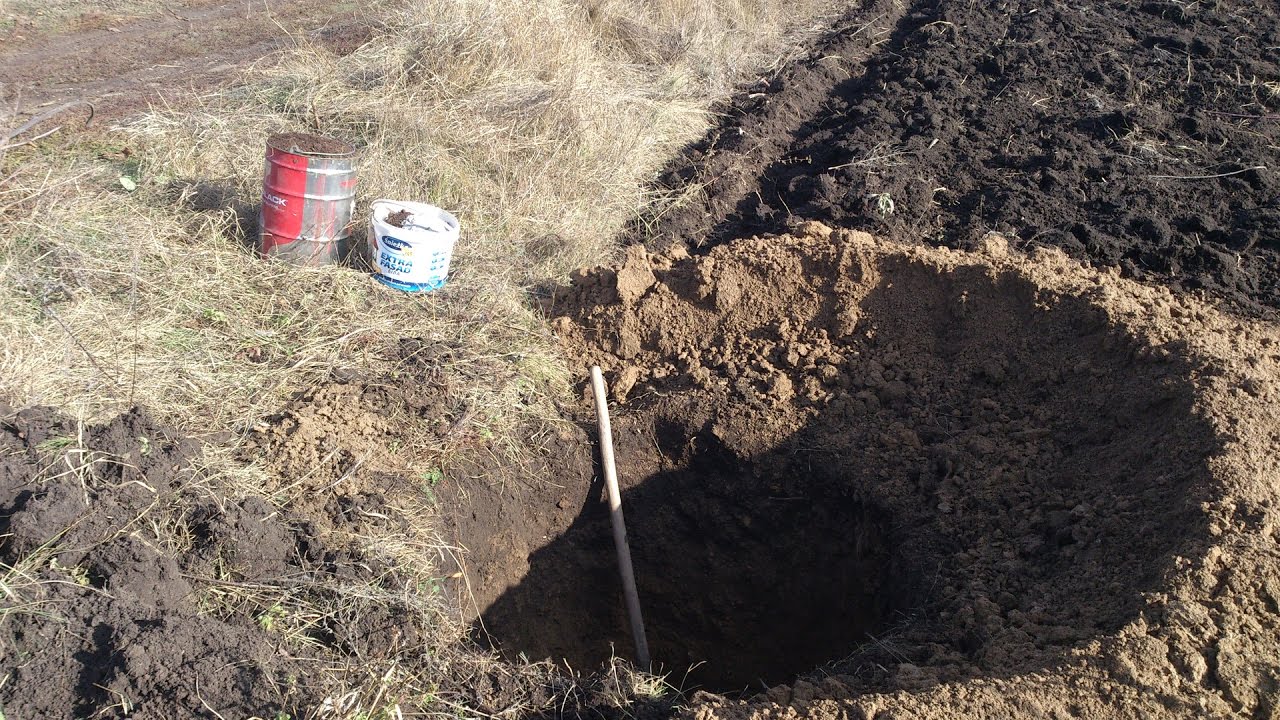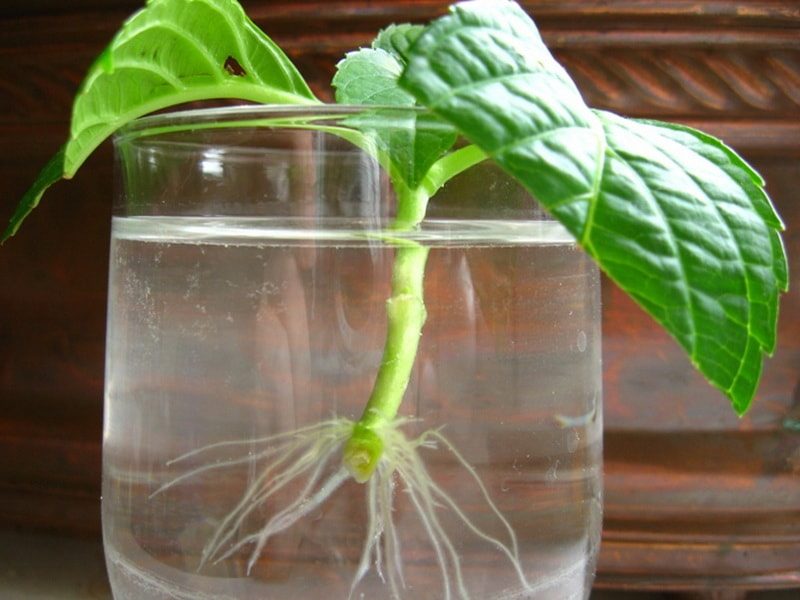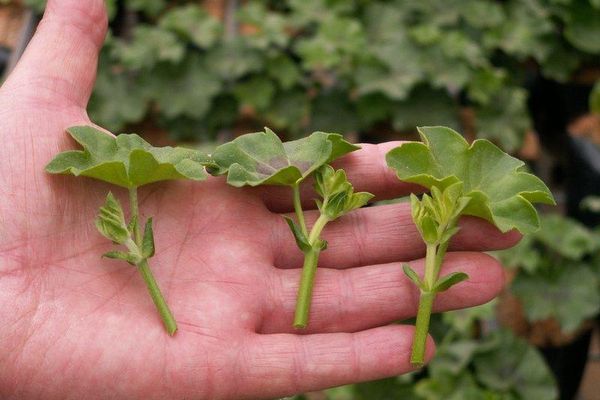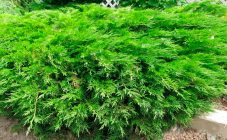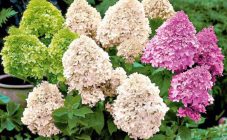Content:
How hydrangea reproduces
Seed propagation
Hydrangea reproduces in several ways. Many gardeners prefer the seed method. How is it convenient? When buying and germinating seeds, you can get a large number of sprouts that can be used as a green hedge when planting. Hydrangea seeds are sown for seedlings in the third decade of February. Loose soil is selected for it. Most often it is a mixture of leafy substrate, peat soil and sand, in a ratio of 4: 2: 1. Further, the seeds are covered with a thin layer of soil, which must be moistened and covered with a film.
Reproduction by layering
This plant can be propagated by layering. This method is most relevant to use at the beginning of summer, until the buds have blossomed. To breed the plant in this way, the lowest young shoots are attached to a groove dug to a depth of 15 cm. A small incision should be made on the outside of the branch and a match should be placed in it. This will speed up the root formation process. Then the escape is covered with earth. The moistening of the earth must be constantly monitored. It shouldn't dry out. In the fall, the cuttings will have their own root system, and they can be transplanted from the main bush. But the cuttings are not yet strong enough to plant them in a permanent place on the site. Therefore, it is grown in greenhouse conditions. In the spring of next year, it can be placed in the open field on the site. Propagation of hydrangea by layering in the summer will not be difficult. For abundant flowering, frequent watering is required.
Hydrangea cuttings
Cutting hydrangeas in summer is the most common method of flower propagation, which is carried out by gardeners. How to propagate hydrangea by cuttings in summer? To do this, green shoots are cut from the hydrangea bush, the lower part of which is already stiff.
The most favorable period is the appearance of buds. The top of the shoot is cut under three pairs of leaves. The bottom pair of leaves is removed, the top of the leaf is trimmed off the other two pairs. For a while, the cuttings are immersed in water with the addition of any growth stimulant. After the cuttings, it is necessary to root. To do this, they are planted in wet sand, to a depth of 3 centimeters, at an angle of 40-60 degrees. Leaves, cut in half, should not touch either the sand or each other. The container is covered with glass or foil and left in the shade. Roots will form in a month. After the roots have appeared, the cuttings are planted in different containers and left in the same shade. In the spring, the growth of planting material will noticeably accelerate, and the cultivation of a flower can be done in its permanent habitat.
Which germination method is better
How can you cut a hydrangea in summer? In the open field, large-leaved hydrangea can be cuttings in summer. For high-quality planting material, a young shoot is cut.Its height should not exceed 17 cm. All lower leaves break off. A hole is dug in the ground, 30x30 cm wide. The depth should be about 40 cm. This will provide freedom for the future root system. It is necessary to pour about 3 buckets of water into the pit so that the earth is saturated with moisture and not overdried.
The soil before planting a flower should be saturated with vitamins. For this, dry mineral fertilizers are suitable. You can also use special fertilizers for hydrangeas, which are purchased at any specialized store. Fertilizers are mixed with the soil, poured into the pit. In the resulting mixture, he makes a depression, the size is suitable for a young shoot. After planting the shoot, the earth is pressed with hands. If there is free space in the hole, it is filled with a substrate for hydrangeas. The land in which the plant is planted needs constant watering. It is best to mulch the soil so that the earth does not dry out so quickly.
The method of cutting hydrangeas in water is less energy intensive. The container in which the hydrangea germinates must be transparent. The process of formation of the root system is better seen in it. A sprouting flower in water can be at home or in greenhouses, which will help protect it from many pests and diseases, as well as from unstable air temperatures.
Ways of germinating cuttings of hydrangea
Rooting cuttings in water
Propagation of hydrangea by cuttings in the summer can be done in water. This requires a transparent container. Daylight breaks through the walls of such a container, which takes on an important role in the formation of roots at this stage. After 2.5 weeks, the roots of the cuttings reach 4 cm.With such a length of the root system, the plant calmly transfers to open ground and care according to the usual scheme. At first glance, this method seems pretty straightforward. But with a long stay in water in the root system, the process of decay may begin, and the cuttings will die. For prophylaxis, the water in the container is changed three times a week. The black activated carbon tablet will also strengthen the root system and prevent the decay process from starting.
Rooting process
When hydrangeas are germinated in water, you can observe the development of the root system, and if something goes wrong, you can change the germination tactics. In the open field, the growth of roots cannot be observed. And, if the plant begins to die, then, as a rule, it is no longer possible to save it. But, if the plant started to grow, it received a fairly strong immunity to lower temperatures.
Cutting tree hydrangea
Treelike hydrangea grows as a shrub, the height of which can reach 2 meters. Treelike and panicle hydrangea are best suited for grafting. Cuttings that have survived the winter in greenhouse conditions are capable of growing outdoors. In order to plant a bush stalk, you need to choose a place on the site. It is best chosen in partial shade. A strong shadow will slow down the growth and development of the bush, and in the open sun the flower will dry out. Potash-phosphorus fertilizers are added to the hole dug for the bush. The stalk is transferred to open ground along with a lump of earth on the roots, in which it grew throughout the winter. To get a lush and beautiful bush when planting, the cutting needs pruning. It is recommended to cut off more than half of the planting material.
Tips for grafting hydrangeas
Cutting hydrangeas is the most effective way to get hold of this flowering plant in your area. The method gives the most positive results, therefore it is the most common. The optimal time for cuttings is considered to be the end of May - beginning of June. A cut is any shoot that has one or more buds. Shoots that grow at the bottom of the bush are best suited for cuttings. For quick rooting, young shoots are cut either in the morning or in cloudy weather.The parent plant should be healthy and well saturated with moisture. After that, roots should be formed on the young shoot. It will take a little time - on average about a month. Summer cuttings, after the roots appear, can be planted on the site. But for the period when the temperature drops, they should be covered.
Only one summer month is not suitable for the reproduction of this plant - July. You can also cut it in late August - early September. The planting material that was taken in the fall needs to be germinated at home or in a greenhouse. Otherwise, the root system will not have time to form before the first frost, and the plant cannot be saved. Autumn cuttings are planted in a container and grown in a greenhouse or at home.
Immediately after cutting the cuttings, they must be placed in water. Do not make the plant thirsty. The top of the cut young shoots must be removed. The cut from the bottom and the cut from the top should be at least 1 cm from the kidney. Slices should be done at an angle. Before planting the shoots, it is recommended to treat the place of the upper cut with wax, paraffin or brilliant green. It is advisable to cover the cuttings. If they are covered, then watering must be done 2 times a week. If the cuttings are left open, then watering should be done much more often, approximately once a day. In order to understand whether the stalk has taken root or not, one should look at the upper bud. If the stalk has taken root, the upper bud will begin to swell. Until the first leaves appear, the shelter, which created the greenhouse effect over the plant, can not be removed.
Hydrangea is a gorgeous plant that pleases the gardener with its flowering for a long time: from late spring to the onset of the first frost. Hydrangea is a very moisture-loving plant. It does not need special care, but it needs constant watering. To reduce the amount of watering, the soil must be mulched. If you follow all the features of caring for this beautiful plant, it will delight the gardener's eye with its beautiful and bright flowers for many years.
